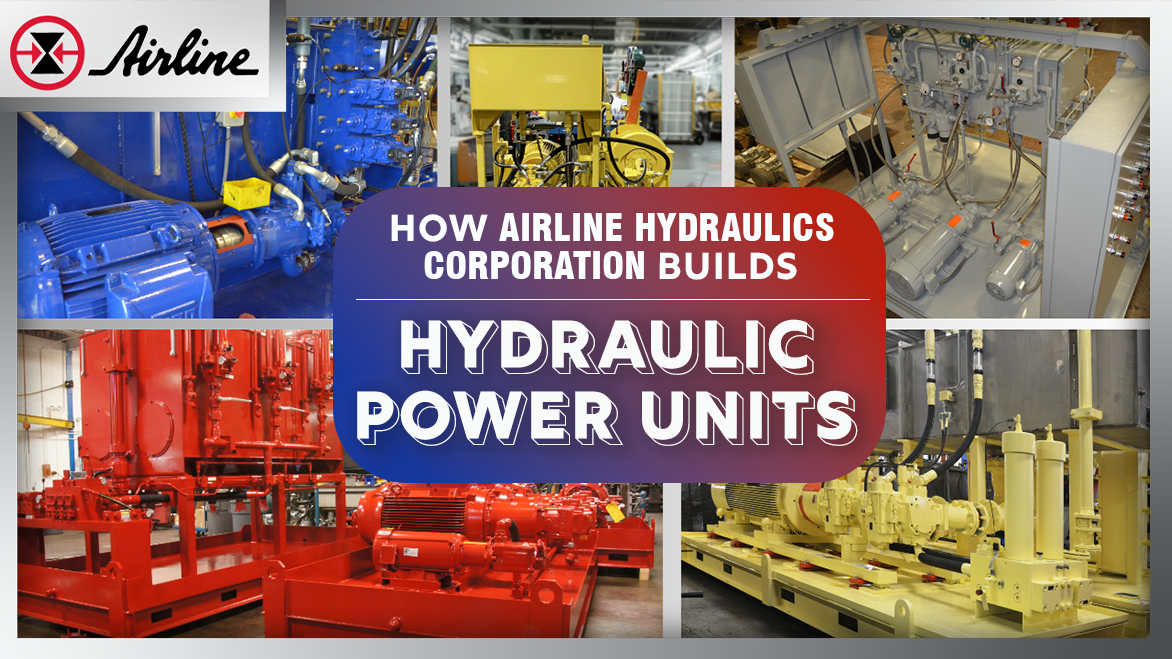At Airline Hydraulics, hydraulic power units (HPUs) are at the heart of what we do. For decades, we have been crafting them for some of the industry's most prominent names.
In this blog post, we invite you to step into our facilities for an exclusive behind-the-scenes look at our renowned production process. From the initial design phase to the final touches on our finished products, learn how our skilled engineers and technicians harness their expertise to create highly specialized units that set industry standards.
Ready to see how it's done? Let’s review our process, which guarantees a high-performance HPU every time.
In this Post
Watch Us Build a Hydraulic Power Unit | HPU Process at Airline Hydraulics | Scaling the Hydraulic Power Unit Build Process | Optimizing Energy Efficiency and Performance | Common Challenges and Our Solutions | How Do I Source a Hydraulic Power Unit? | Additional Resources
🛠️ Explore Our Hydraulic Power Unit Services
The Hydraulic Power Unit Built Process at Airline Hydraulics
Our HPU project process is meticulously planned and executed by a skilled team of engineers and technicians. Here's what you can expect when you choose Airline Hydraulics for your HPU needs:
1. The Power of Understanding Your Needs
First, we identify your specific system needs. While many customers approach us with only a general idea, our team excels at translating those initial concepts into detailed specifications.
Our approach is proactive and comprehensive. We begin by asking questions about the desired system parameters, such as pressure, flow rate, and operational environment. This collaborative process helps us shape the project, ensuring we design a solution tailored to your unique needs.
This focus on collaboration is beneficial for everyone involved, as a full understanding of the project requirements ultimately results in a more efficient and effective HPU.
Check out our hydraulic power unit capabilities by exploring our HPU photo gallery below.
|
Need help defining your system parameters? Schedule a free consultation with our engineering team today. |
2. Crafting a Comprehensive Proposal
Next, we create a performance specification and scope document. This document is a roadmap that outlines what you can expect in terms of production output and system capabilities. We ensure it’s something everyone can understand, from decision-makers at all levels to engineers and CFOs.
Safety considerations are integral to this phase. We make sure to ask about any specific safety or SIL (Safety Integrity Level) requirements and integrate them into the scope document. This ensures that safety is prioritized alongside functionality, providing peace of mind from the outset.
Want an idea of what to expect? Check out a sample of an HPU scope document.

3. Engineering Review and Validation
With the scope document in hand, our engineering team conducts a thorough review. They confirm that all technical requirements can be met and may suggest refinements to optimize performance. This stage is crucial for validating the customer’s needs and translating them into a functional hydraulic system.
The engineering review serves as a checkpoint, ensuring that all parties are aligned before moving forward. It’s an opportunity to leverage our engineering expertise, guaranteeing that the proposed solution is feasible and efficient.
|
Ready to validate your project’s specs? |
What makes a quality hydraulic power unit stand out? Let's dive into how our component selection process ensures each unit meets industry standards.
4. Specifying Quality Components
Component selection is a critical step in building a hydraulic power unit. With the scope approved, we begin sourcing the necessary components. Quality control starts at this stage; our team meticulously checks each part to ensure it meets the specified requirements.
This phase involves collaboration between procurement specialists and engineers. By working together, we ensure that every component—from actuators to control valves—is perfectly suited to the system's needs. Our commitment to quality at this stage sets the tone for the entire build process.
|
Curious about selecting the best components for your hydraulic system? |
5. Configuration and Layout
Once we've sourced the best components, it's time to bring the system to life by laying out each part for maximum efficiency.
Each HPU is unique, and design considerations play a critical role in its success. With these considerations in mind, once the components are in place, our skilled technicians take over.
Each of our technicians has a personalized workstation built with aluminum extrusion and featuring a 32-inch monitor. This setup allows them to access and interact with 3D project drawings, allowing them to rotate, zoom in, and zoom out to understand every detail of the layout. They also have a direct line of communication with engineers and project managers, ensuring seamless collaboration on each system.
|
Want to see how our 3D modeling could work for your project? |
6. Assembly
After finalizing the layout and ensuring every component is perfectly positioned, our skilled technicians are ready to bring the unit to life.
This next phase, the assembly, is where precision and craftsmanship come together to create a fully functional hydraulic power unit.
The assembly process involves piecing together components and closely monitoring fitment and design. Attention to detail is paramount. If the system includes a manifold, it is typically assembled and removed before painting to ensure longevity. Custom paint thicknesses are applied as needed, contributing to the unit's durability and appearance.
Take a behind-the-scenes and see our experts in action! Watch the build of a customized hydraulic power unit, from start to finish, in under three minutes.
7. Coating Prep and Applying Coating
After precise assembly, the next step is crucial—protecting our hard work with a durable coating that ensures longevity and performance.
To ensure durability, we meticulously prepare each system for coating by cleaning it thoroughly to remove any impurities or contaminants. Our standard two-part epoxy paint, known for its exceptional adhesion and durability, is applied precisely.
We offer an extensive range of custom colors based on customer specifications, allowing for personalization and alignment with brand identity. After applying the paint, we thoroughly check its thickness using advanced measurement tools to ensure it meets specific industry and client requirements, guaranteeing both functionality and aesthetic appeal.
|
Interested in customized colors or coatings? |
Manifold Assembly
If your project involves manifolds and is made of aluminum, we initially assemble the manifold but remove it before painting. The crucial step is inspecting the manifolds to ensure they are clean and free of burrs or debris. Once cleared, we proceed with the assembly. The complete manifold is then subjected to functional testing during the system run.
8. Electrical Setup and Installation
With a durable coating applied to protect against harsh conditions, it's time to integrate the brains of the operation—electrical systems that bring precision and control to every hydraulic power unit we produce. In this next phase, our electrical team carefully installs the wiring and control mechanisms to ensure seamless operation.
Our control systems adjust in real-time, giving you peace of mind that your system is always running smoothly. So, after the coating is done, our electrical team gets to work on integrating the enclosure and running all the necessary cables.
Setting up an electrical system requires a close attention to detail and many years of experience. It’s all about fine-tuning control mechanisms. This means setting switches and adjusting each component to guarantee optimal functionality.
9. Testing and Calibration
With the electrical setup complete and all control systems in place, it's time to ensure everything works flawlessly. In the testing and calibration phase, we put every component to the test to verify that the hydraulic power unit performs precisely as intended, providing the reliability our customers count on
We rigorously test each component to ensure 100% functionality, employing thorough procedures and technology to guarantee reliability and performance. Utilizing calibrated test equipment and comprehensive data logging, we provide our clients with detailed, accurate performance data, offering insight into every aspect of the system’s operation.
We offer in-person or virtual witness tests to allow customers to observe their unit’s testing from anywhere in the world. This significantly saves time and reduces travel costs while ensuring their peace of mind. Customers can request specific adjustments that ensure the final product is tailored precisely to their needs.
Once testing is complete, we meticulously document the results to provide customers with a comprehensive record of the system’s capabilities. This documentation includes performance specs, safety verifications, and any certifications required for compliance. After a final safety check and inspection by our shop foreman and quality assurance team, the hydraulic power unit is ready for delivery.
10. The Final Product, Ready for Safe Shipment
Once testing and calibration confirm that every component is functioning at its peak, we’re ready to prepare the unit for its journey to you. In the final stage, our packaging team carefully crates the fully assembled system, ensuring it arrives in perfect condition and ready for seamless integration
Our custom packaging team meticulously crates the fully assembled and verified hydraulic system. Our lumber is heat-treated and stamped for overseas shipments, allowing us to ship globally.
|
Need global delivery? |
Scaling the Hydraulic Power Unit Build Process
For orders with multiple systems, whenever possible, we employ batch building. While this approach varies by project, it often yields savings not only in construction but also during testing.
Setting up for a test once allows us to switch between systems efficiently, significantly reducing testing time. Initial setup of a test circuit can take a few hours as we ensure comprehensive testing of all components. Setting up once simplifies the process of merely disconnecting and connecting each system, saving considerable time.
|
Considering multiple systems? |
Optimizing Energy Efficiency and Performance
We design each HPU with energy efficiency and top performance in mind, tailoring it to specific pressure and flow needs. Using advanced SCADA systems and IoT-enabled sensors, we continuously track real-time data on pressure, flow, and temperature, allowing us to fine-tune systems for maximum efficiency.
This proactive monitoring not only minimizes component wear but also extends the system lifespan and reduces costly downtime. By integrating AI-driven predictive maintenance algorithms and leveraging the latest innovations in hydraulic technology, we ensure our HPUs consistently exceed ISO 9001 standards for quality and reliability.
Common Challenges and Our Solutions
Like any process, you're going to run into some challenges. While building hydraulic power units, we encounter challenges such as supply chain delays, which can impede progress and lead to project setbacks. Our solution is to work closely with our preferred vendors, establishing strong relationships and maintaining flexibility in sourcing local components to mitigate any disruptions.
How Do I Source a Hydraulic Power Unit? It All Begins With The First Step
Choosing the right partner for your hydraulic power unit project makes all the difference in your operations. At Airline, we combine expertise, innovation, and dedication to deliver HPUs that enhance performance and reliability.
Looking for ways to improve or enhance your hydraulic systems? Check out our expert HPU services for a reliable, efficient solution. Whether you're designing a custom system or upgrading an existing one, our team is here to make it happen.
Additional Resources
- HPU services
- Hydraulic Systems and Components
- Smart HPU
- Hydraulic Power Unit Refurbishment | Turn that old HPU to NEW! ✨









Leave Comment